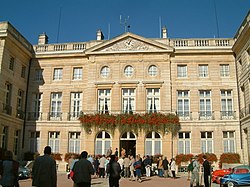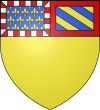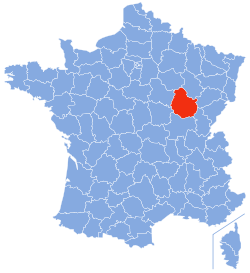Côte-d'Or
This article may be expanded with text translated from the corresponding article in French. (January 2009) Click [show] for important translation instructions.
|
Cote-d'Or | |
|---|---|
Department | |
 Prefecture building of the Côte-d'Or department, in Dijon | |
 Flag  Coat of arms | |
 Location of Côte-d'Or in France | |
| Coordinates: 47°25′N 04°50′E / 47.417°N 4.833°E / 47.417; 4.833Coordinates: 47°25′N 04°50′E / 47.417°N 4.833°E / 47.417; 4.833 | |
| Country | France |
| Region | Bourgogne-Franche-Comté |
| Prefecture | Dijon |
| Subprefectures | Beaune Montbard |
| Government | |
| • President of the General Council | François Sauvadet (NC) |
| Area 1 | |
| • Total | 8,763 km2 (3,383 sq mi) |
| Highest elevation | 723 m (2,372 ft) |
| Population (2016) | |
| • Total | 533,213 |
| • Rank | 49th |
| • Density | 61/km2 (160/sq mi) |
| Demonyms | côte-d'oriens, costaloriens |
| Time zone | UTC+1 (CET) |
| • Summer (DST) | UTC+2 (CEST) |
| Department number | 21 |
| Arrondissements | 3 |
| Cantons | 23 |
| Communes | 698 |
^1 French Land Register data, which exclude estuaries, and lakes, ponds, and glaciers larger than 1 km2 | |
Côte-d'Or (IPA: [kot dɔʁ]; literally, "golden slope") is a department in Bourgogne-Franche-Comté.
Contents
1 History
2 Geography
3 Climate
4 Politics
4.1 Current National Assembly Representatives
5 Economy
6 Demographics
7 Tourism
8 See also
9 References
10 External links
History
Côte-d'Or is one of the original 83 departments created during the French Revolution on 4 March 1790. It was formed from part of the former province of Burgundy.
Geography
The department is part of the current region of Bourgogne-Franche-Comté. It is surrounded by the departments of Yonne, Nièvre, Saône-et-Loire, Jura, Aube, and Haute-Marne.
A chain of hills called the Plateau de Langres runs from north-east to south-west through the department to the north of Dijon and continues south-westwards as the Côte d'Or escarpment, which takes its name from that of the department. It is the south-east facing slope of this escarpment which is the site of the celebrated Burgundy vineyards. To the west of the Plateau de Langres, towards Champagne, lies the densely wooded district of Châtillonais. To the south-east of the plateau and escarpment, the department lies in the broad, flat-bottomed valley of the middle course of the Saône.
Rivers include:
- The Saône
- The Seine rises in the southern end of the Plateau de Langres.
- The Ouche rises on the dip slope of the escarpment and flows to the Saône via Dijon.
- The Armançon rises on the dip slope of the escarpment and flows north-westward.
- The Arroux rises on the dip slope of the escarpment at the southern end of the department.
Climate
The climate of the department is temperate, with abundant rain on the west side of the central range.
Politics
The President of the General Council is François Sauvadet of the New Centre.
| Party | seats | |
|---|---|---|
| Socialist Party | 12 | |
• | Union for a Popular Movement | 11 |
• | Miscellaneous Right | 8 |
| Miscellaneous Left | 6 | |
| Left Radical Party | 3 | |
• | New Centre | 2 |
• | MoDem | 1 |
Current National Assembly Representatives
| Constituency | Member[1] | Party | |
|---|---|---|---|
Côte-d'Or's 1st constituency | Didier Martin | La République En Marche! | |
Côte-d'Or's 2nd constituency | Rémi Delatte | The Republicans | |
Côte-d'Or's 3rd constituency | Fadila Khattabi | La République En Marche! | |
Côte-d'Or's 4th constituency | Yolaine de Courson | La République En Marche! | |
Côte-d'Or's 5th constituency | Didier Paris | La République En Marche! | |
Economy
This is a premier wine-growing region of France. It produces what are arguably the world's finest, and definitely most expensive Pinot noir and Chardonnay wines from some of the most rigorously and painstakingly (thanks to the region's many monasteries) classified vineyards in the world. Wine from the Côte-d'Or was a favorite of the emperor Charlemagne. Other crops include cereal grains and potatoes. Sheep and cattle are also raised in the department. The region is famous for its Dijon mustard.
There are coal mines and heavy industry, including steel, machinery, and earthenware.
The industries most developed in Côte-d'Or are
- agriculture and food (14% of employees)
- metallurgy and metal manufacture (12% of employees)
- chemicals, rubber and plastics (12% of employees)
- pharmacy
- electrical and electronic components and equipment
- wood and paper industries.
The big works are generally in the conurbation of Dijon although biggest (CEA Valduc) is at Salives in the Plateau de Langres. There is also the SEB metal works at Selongey below the plateau on the margin of the Saône plain and the Valourec metalworking group at Montbard in the west of the department on the River Brenne near its confluence with the Armançon.
The Pharmaceutical industry has shown the greatest growth in recent years.
However, since the Dijon employment statistics zone includes the urban and administrative centre of the Burgundy region, the service sector is proportionately bigger there in relation to the industrial, than in the other three zones of Côte-d'Or.
- Reference Industry in Bourgogne website
Demographics
The inhabitants of the department are called Costaloriens.
Tourism
Some of the major tourist attractions are the Gothic abbey church of Saint-Seine-l'Abbaye and the Romanesque abbey church at Saulieu, as well the Château de Bussy Rabutin at Bussy-le-Grand. The Abbey of Cîteaux, headquarters of the Cistercian Order, lies to the east of Nuits-Saint-Georges in the south of the department.
Palace of the Dukes of Burgundy in Dijon

Hospices de Beaune

Abbey of Fontenay

Château de la Rochepot
Clos de Vougeot, Burgundy wine

Reenactment of the siege of Alesia in Alise-Sainte-Reine
See also
- French wine
- Cantons of the Côte-d'Or department
- Communes of the Côte-d'Or department
- Arrondissements of the Côte-d'Or department
References
^ http://www.assemblee-nationale.fr/
External links
Wikisource has the text of the 1911 Encyclopædia Britannica article Côte-d'Or. |
(in French) Prefecture website
(in French) Council website
(in English) Cote-d'Or at Curlie
(in French) Photos Gallery of Dijon and the Côte D'or





